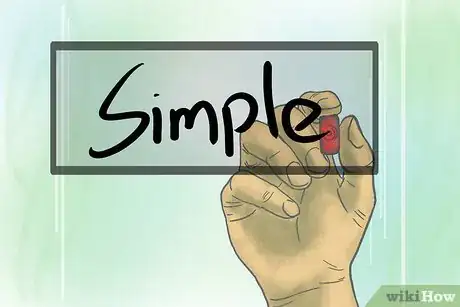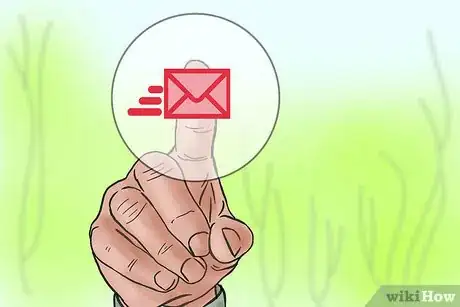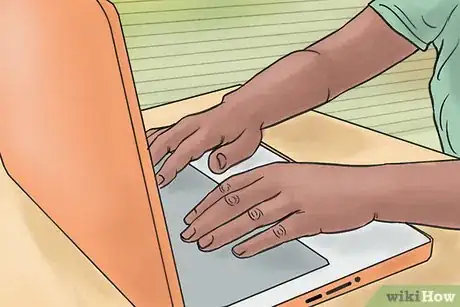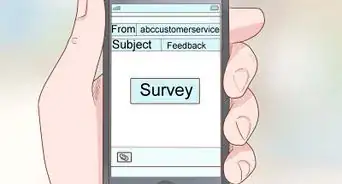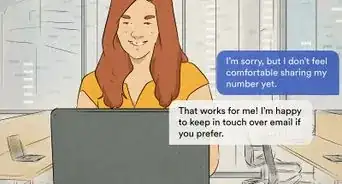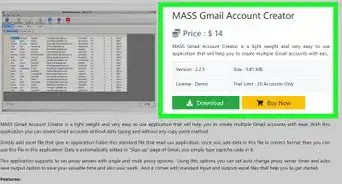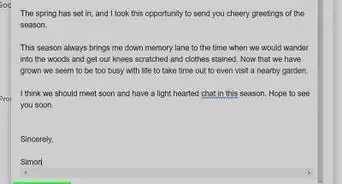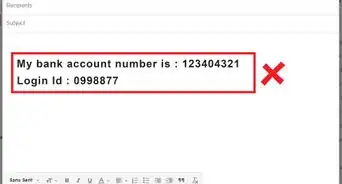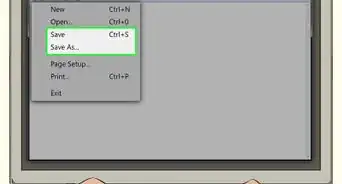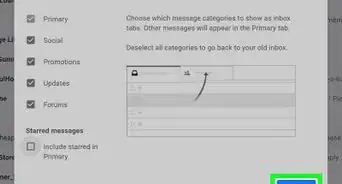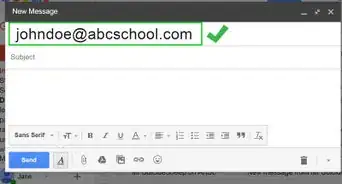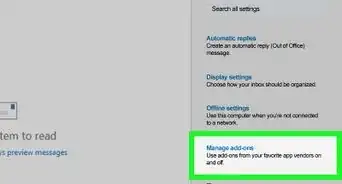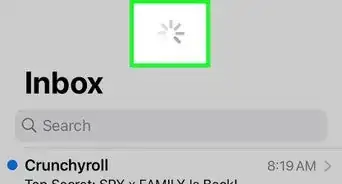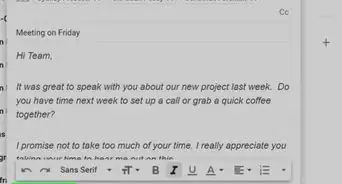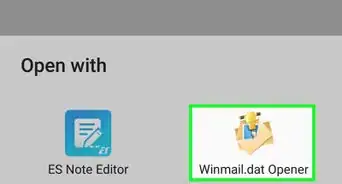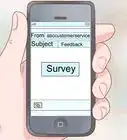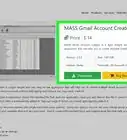This article was co-authored by Ross Taylor and by wikiHow staff writer, Amber Crain. Ross Taylor is a Marketing Expert and the Founder of Alameda Internet Marketing. With over 10 years of experience, Ross specializes in Search Engine Optimization (SEO) and Search Engine Marketing (SEM). Ross’ boutique SEO agency is a Google Partner agency, which has been recognized for its dedication to honest communication and quality service with awards from UpCity, ThreeBestRated.com, and Clutch. Ross holds an Associate of Arts degree from Chabot College and certifications in Google AdWords and CompTIA A+.
There are 8 references cited in this article, which can be found at the bottom of the page.
This article has been viewed 79,338 times.
Email marketing is a valuable and inexpensive way to promote your brand, reach out to customers, and provide special offers. Generating effective content is only one piece of the puzzle–we'll share the things should and shouldn’t do when interacting with people via email.
Steps
Creating Email Lists
-
1Build your email list. The three most important groups to market to via email are your current customers, past customers, and prospective customers. Use a spreadsheet to create a database of their names and email addresses. If you don’t already have the email addresses, you’ll need to start collecting them. To build your list, use your website, storefront, front desk, and every phone call to request your visitor's email address.[1]
- Keep a clipboard at the front desk or storefront of your business for people to sign up for your email list.
- Entice them into signing up by offering discount coupons and other advantages that will only be sent via email. Make it relevant to what they are currently doing. Are they reading a long how-to guide? Then offer a summarized actionable checklist in exchange for their email.
- You can also offer something to your audience that matches your niche. For instance, if you run a health-related company, you might offer a free guide to losing 5 lb (2.3 kg) in 30 days to anyone who joins your email list. Basically, you want to incentivise the prospect to sign up by offering them something in return. [2]
- All you need is their name and email address to get started. Don’t ask for too much information at this point.
-
2Promise privacy. Many people will be reluctant to sign up for an email list unless you assure them you will keep their email addresses and personal information private. This should be promised upfront. Along with the initial promise, you should develop a privacy statement that will be included at the bottom of every email you send out. This statement should be brief and to the point.
- Privacy statements should state that your company will never give out email addresses to third parties and will only be used for the purposes of marketing your company’s products and services.
- It should also be mentioned that the email content is confidential and intended only for the individual named.
- Also state that if the email has been received in error, the recipient should notify the company so that their email can be deleted from the email list.[3]
- Example: Your privacy is important to us. We will not disclose your personal information to any third party unless you have given us consent or we are required to do so by law. If you do not wish to receive communication from this company, you can opt out by replying to this email and notifying us.
Advertisement -
3Create different email lists. Keep email addresses organized in spreadsheets and make sure you separate them. At minimum, you should have the emails broken into lists of current customers, past customers and prospective customers. Creating separate email lists allows you to send different emails to the groups, each with their own targeted content. As you go along, you can get more specific with your lists for even better targeting.
Generating Effective Content
-
1Have clear and specific goals in mind. Remember the acronym "AIDA" as you compose the message – Attention, Interest, Desire, Action.[6] Your subject line needs to get their “attention” so that they’ll open the email. Once they’ve opened it, spark their “interest” so they’ll want to continue reading it. Create “desire” by providing them with a motivating offer. Finally, they need to be moved to “action” – which can be clicking on a link, calling your business, buying something from your website, and so on.
- For example, a dance class instructor who teaches couples could effectively market via email by offering a promotion for a free one hour introductory class. This offer would create desire, which could be further solidified by including a positive testimonial from a current student.
- Since the primary targets are couples, a subject line like, “Do you want to take your relationship to the next level?” would be an effective way to get the attention of a prospect.
-
2Write an effective subject line.[7] Always remember the risk of being flagged as spam. A good subject line can diminish that possibility. It's best to write a subject line of less than 40 characters. 20 to 30 is probably optimal.
- Tell your recipients what’s new in terms of products, services and relevant business information.
- Using the words “how to” is a great way to get your email opened; connect your solution to the recipients' needs.
- Make a compelling offer that will interest the recipient. Offers are usually discounts or special pricing.
- For example, a good subject line that a POS software company could use when marketing to restaurant owners would be, "Our new security feature will eliminate internal theft" or "How to eliminate internal theft."
-
3Provide interesting content. Avoid obvious sales pitches. Instead of immediately pitching your product, make the email about your readers. Instead of long-winded descriptions of your products and all the amazing services you provide, write about problems that might be afflicting your readers, then introduce solutions that include your products and services.[8]
- Just as the subject line should prompt them to open the email, your intro needs to do one thing – get them to read the rest of the email.
- To capture interest, try telling a story, building mystery, and/or including a relevant and compelling image in the email body.
- For example, instead of announcing a new feature by describing it in technological terms, you could instead talk about the benefits of the feature that will directly and positively affect a prospective customer. Focusing on a customer's needs will get their attention.
- You could make key statements using bulletpoints, which would succinctly convey information while also emphasizing it.
-
4Keep it simple and easy to read.[9] People receive a lot of emails every day and you probably aren’t going to have their undivided attention. Make sure the email is easy for the recipient to scan through quickly. Break the content up into short paragraphs. Stay on point and be clear.[10] [11] Include relevant images to break up the text.
- If you have an offer that requires a good deal of information, provide a “Read more” link. If they’re interested, they can click that link and be taken to a web page that provides additional information.
- Start with the most important information at the top of the email.
- Don't include too many graphics or fancy designs in your emails. These might be difficult for mobile users to read.[12]
-
5Create an action-oriented goal.[13] Your email should entice and prompt the recipients to take some kind of action. However, action does not necessarily mean getting them to buy something immediately. The goal could be getting them to reply to the email or even just getting them to click a link that brings them to your website. While people do manage to sell in their emails and drop people straight onto a credit card page, you will have more success getting people interested in reading more about your offer.
- Make sure the action goal is something that you can track – like a click, reply or a phone call – through platforms like Google Analytics.
- It’s important to monitor the effectiveness of your email marketing campaigns, and the only way you can do that is by providing a call-to-action that you can track.
Sending the Email
-
1Send a welcome email and provide an opt-in option.[14] Before you start marketing to someone new, you should first send a welcome email. Introduce the company and let them know what to expect from future emails. Provide an opt-in form that allows them to confirm that they want to receive further emails from you. To give them incentive to opt-in, provide an attractive offer in the welcome email.[15]
- For example, you could offer a free product or discount with their next purchase.
- An opt-in option can help prevent you from spamming people and get your relationship with that person started on the right foot.
- Every email you send should also have an obvious unsubscribe link in it. This allows the person to opt-out at any time.
-
2Send a test email first.[16] Once you hit “send” on an email, there’s no going back. You can’t make corrections or change any of the content. Before you send an email out to your entire email list, send it to a few key people in your company. Have these people review the email content, confirm that all the links work, proofread the text, make sure the formatting looks right, etc.
- You will feel a lot more comfortable and confident about sending the final email out to your list if you do a test send first.
-
3Track the effectiveness through analytics. Most email service providers include free analytics when you use their programs. These analytics provide a great deal of information about the email’s effectiveness, but the three most important metrics are the open rate, click through rate (CTR), and unsubscribes. Knowing this information can help you tweak your content for more successful email marketing in the future.
- The open rate tells you how effective your subject line was by showing you how many people opened the email and how many people didn’t.
- CTR shows you how many people heeded the call-to-action, which essentially tells you how successful your content was.
- Unsubscribe information lets you know when you’ve created ineffective content because it tracks how many people opted-out of receiving future emails from you after seeing the current one.
Expert Q&A
-
QuestionWhat is the key to an effective email campaign?
 Ross TaylorRoss Taylor is a Marketing Expert and the Founder of Alameda Internet Marketing. With over 10 years of experience, Ross specializes in Search Engine Optimization (SEO) and Search Engine Marketing (SEM). Ross’ boutique SEO agency is a Google Partner agency, which has been recognized for its dedication to honest communication and quality service with awards from UpCity, ThreeBestRated.com, and Clutch. Ross holds an Associate of Arts degree from Chabot College and certifications in Google AdWords and CompTIA A+.
Ross TaylorRoss Taylor is a Marketing Expert and the Founder of Alameda Internet Marketing. With over 10 years of experience, Ross specializes in Search Engine Optimization (SEO) and Search Engine Marketing (SEM). Ross’ boutique SEO agency is a Google Partner agency, which has been recognized for its dedication to honest communication and quality service with awards from UpCity, ThreeBestRated.com, and Clutch. Ross holds an Associate of Arts degree from Chabot College and certifications in Google AdWords and CompTIA A+.
Marketing Expert The key is consistency. You want to make sure that you're sending messages to your audience on a regular basis. If you wait too long, your audience will forget that they had an engagement in the first place.
The key is consistency. You want to make sure that you're sending messages to your audience on a regular basis. If you wait too long, your audience will forget that they had an engagement in the first place. -
QuestionWhat makes a good email?
 Ross TaylorRoss Taylor is a Marketing Expert and the Founder of Alameda Internet Marketing. With over 10 years of experience, Ross specializes in Search Engine Optimization (SEO) and Search Engine Marketing (SEM). Ross’ boutique SEO agency is a Google Partner agency, which has been recognized for its dedication to honest communication and quality service with awards from UpCity, ThreeBestRated.com, and Clutch. Ross holds an Associate of Arts degree from Chabot College and certifications in Google AdWords and CompTIA A+.
Ross TaylorRoss Taylor is a Marketing Expert and the Founder of Alameda Internet Marketing. With over 10 years of experience, Ross specializes in Search Engine Optimization (SEO) and Search Engine Marketing (SEM). Ross’ boutique SEO agency is a Google Partner agency, which has been recognized for its dedication to honest communication and quality service with awards from UpCity, ThreeBestRated.com, and Clutch. Ross holds an Associate of Arts degree from Chabot College and certifications in Google AdWords and CompTIA A+.
Marketing Expert Keep your content short, bite-sized, and accessible to everyone so that they can read quickly on their mobile phone.
Keep your content short, bite-sized, and accessible to everyone so that they can read quickly on their mobile phone. -
QuestionHow do you create an email list?
 Ross TaylorRoss Taylor is a Marketing Expert and the Founder of Alameda Internet Marketing. With over 10 years of experience, Ross specializes in Search Engine Optimization (SEO) and Search Engine Marketing (SEM). Ross’ boutique SEO agency is a Google Partner agency, which has been recognized for its dedication to honest communication and quality service with awards from UpCity, ThreeBestRated.com, and Clutch. Ross holds an Associate of Arts degree from Chabot College and certifications in Google AdWords and CompTIA A+.
Ross TaylorRoss Taylor is a Marketing Expert and the Founder of Alameda Internet Marketing. With over 10 years of experience, Ross specializes in Search Engine Optimization (SEO) and Search Engine Marketing (SEM). Ross’ boutique SEO agency is a Google Partner agency, which has been recognized for its dedication to honest communication and quality service with awards from UpCity, ThreeBestRated.com, and Clutch. Ross holds an Associate of Arts degree from Chabot College and certifications in Google AdWords and CompTIA A+.
Marketing Expert Create a lead magnet. With a lead magnet, you can add people to your list by offering something to your target audience, like a free guide or resource.
Create a lead magnet. With a lead magnet, you can add people to your list by offering something to your target audience, like a free guide or resource.
References
- ↑ http://www.experian.com/small-business/how-to-build-an-email-list.jsp
- ↑ Ross Taylor. Marketing Expert. Expert Interview. 4 May 2021.
- ↑ https://www.exclaimer.com/email-signature-handbook/10065-email-disclaimer-examples
- ↑ http://www.hongkiat.com/blog/email-marketing-tips-to-do-it-well/
- ↑ http://www.copyblogger.com/email-marketing/
- ↑ http://www.pmzmarketing.com.au/articles/Stop_Wasting_your_Marketing_Efforts
- ↑ http://www.hongkiat.com/blog/email-marketing-tips-to-do-it-well/
- ↑ https://blog.kissmetrics.com/beginners-guide-email-marketing/
- ↑ http://www.forbes.com/sites/katelee/2012/10/15/15-email-marketing-tips-for-small-businesses/#3c01d88d384f
- ↑ http://www.hongkiat.com/blog/email-marketing-tips-to-do-it-well/
- ↑ Ross Taylor. Marketing Expert. Expert Interview. 4 May 2021.
- ↑ Ross Taylor. Marketing Expert. Expert Interview. 4 May 2021.
- ↑ https://blog.kissmetrics.com/beginners-guide-email-marketing/
- ↑ http://www.forbes.com/sites/katelee/2012/10/15/15-email-marketing-tips-for-small-businesses/#3c01d88d384f
- ↑ http://www.experian.com/small-business/how-to-build-an-email-list.jsp
- ↑ http://www.hongkiat.com/blog/email-marketing-tips-to-do-it-well/
About This Article
Email marketing can be a great way for you to promote your business and cultivate relationships with your clients directly through email. To do email marketing, start by building an email list using a spreadsheet listing the names and email addresses of your current, past, and future customers. When you’re ready to compose your email, write a compelling 20 to 30 character subject line to persuade the customers to open the email. Then, in the email body, provide your customers with a motivating offer and entice the reader to take an action, such as calling your business. For more tips, like how to create interesting content, read on!







